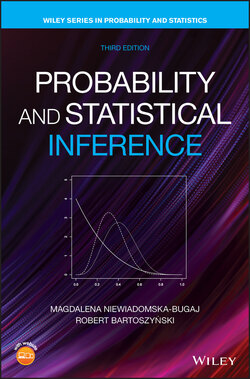Читать книгу Probability and Statistical Inference - Robert Bartoszynski - Страница 73
Solution
ОглавлениеLet and stand for the alphabet and for the set of 10 digits: Then, a license plate from system A can be regarded as an element of , while a license plate in system B is an element of the set . The numbers of elements in these Cartesian products are and . The ratio is , so in the state using an A system 2.6 times more cars can be registered than in the state with a B system.
Regarding system C, the answer depends whether or not 0 is allowed in the prefix. If the plate such as 0HY 314 is not allowed (e.g., because the digit 0 can be confused with the letter O), then the number of possible license plates is only , which is 10% less than the number of plates possible in states using system B. If 0 is allowed as the first character, then the numbers of plates of types and are the same.
In Examples 3.1 through 3.3 the set of ways of performing the second operations is the same regardless of which option was selected for the first operation. However, Theorem 3.2.1 remains true if the sets of ways of performing the second operation depend on the choice of the first operation. In particular, we can think of the first and second operation as two consecutive choices of an element from the same set, without returning the chosen elements. If the set, say , has elements, then the first operation (choice of an element) can be performed in ways. If the chosen element is not returned, then the second choice can be performed in ways only, and we have the following:
Corollary 3.2.4 The number of ordered pairs with that can be formed out of distinct elements of a set of size is .
Instead of thinking in terms of operations, we can still use Cartesian products here. Thus, has elements by Theorem 3.2.3, of which are of the form . The number of pairs with elements distinct is .
We can generalize these considerations as follows:
Definition 3.2.1 An ordered sequence of elements selected without replacement from a set of distinct elements is called a permutation of out of elements.
Theorem 3.2.5 The number of permutations of out of , denoted , equals
Proof: The argument here repeatedly uses the “operation” principle: the first choice can be made in ways, the second in ways, the th in ways.
If , consecutive choices form an ordering of the entire set of size . We obtain the following:
Corollary 3.2.6 The set of elements can be ordered in
(3.2)
distinct ways.
The product (3.2) occurs often and has a special symbol:
to be read “ factorial.” We have therefore
(3.3)
For a reason that will become apparent later, we adopt the convention
(3.4)
